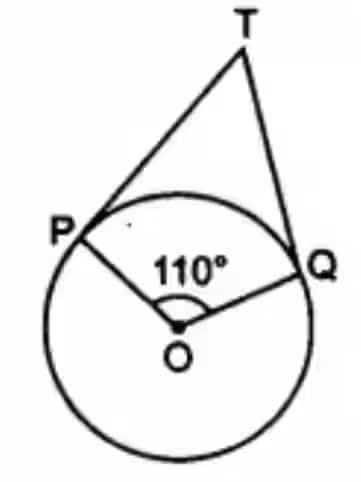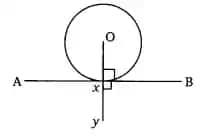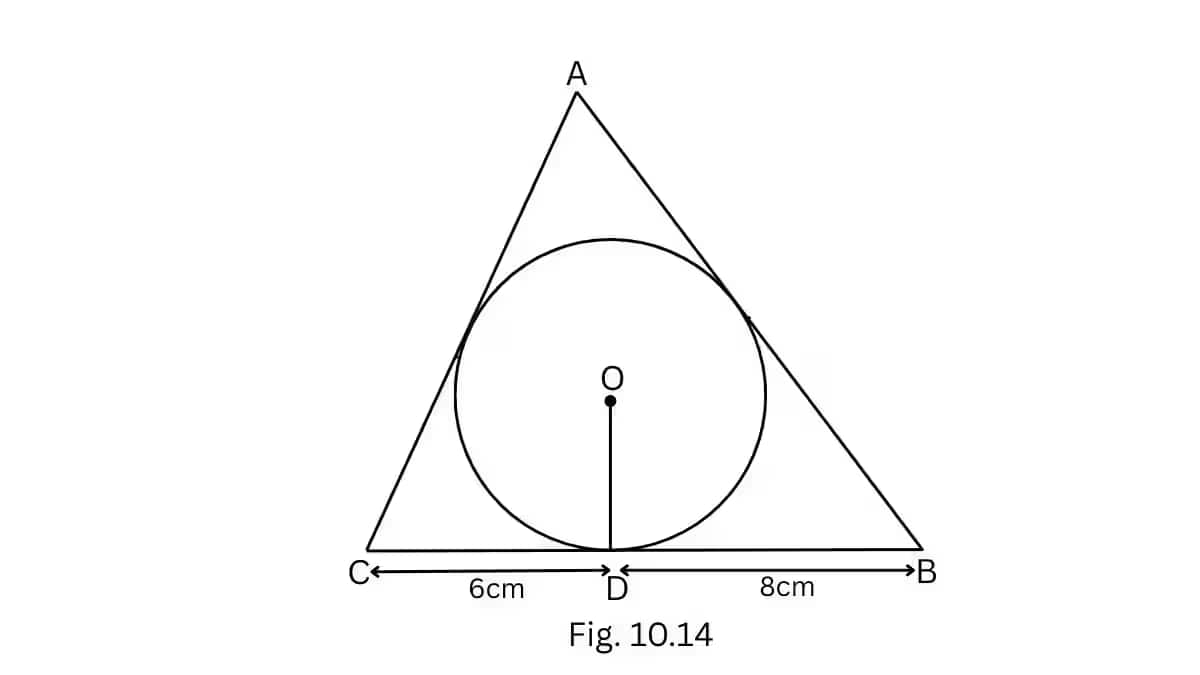NCERT Solutions for Exercise 10.2 Class 10 Maths Chapter 10 - Circles
CBSE Class 10th Exam Date:01 Jan' 26 - 14 Feb' 26
A circle is a geometrical figure in which all the points are equidistant from the circle's centre. Some of the concepts related to the circle, like radius, diameter, and related theorems, have already been discussed in the previous exercise. In this exercise, the questions related to the tangent have been solved. A tangent is a line segment that touches the circle at exactly one point. A secant is a line segment that touches the circle at exactly two points. Some facts related to tangents are that a tangent can not pass through a point that lies inside the circle, there is only one tangent that passes through the point on the circle, and there are exactly two tangents that pass through the point and lie outside the circle.
This Story also Contains
- Download Free Pdf of NCERT Solutions for Class 10 Maths Chapter 10 Exercise 10.2
- Assess NCERT Solutions for Class 10 Maths Chapter 10 Exercise 10.2
- Topics covered in Chapter 10.2 Circles: Exercise 10.2
- NCERT Solutions Subject Wise
- Subject-Wise NCERT Exemplar Solutions
These NCERT solutions are created by our subject matter expert at Careers360, considering the latest syllabus and pattern of CBSE 2025-26. Class 10 maths ex 10.2, which is an exercise followed by exercise 10.1, includes the concept of circles. There are many numerical problems with the number of tangents from a point. This is an important part to cover when we talk about tests and exams. These concepts are easy to understand and can be worked on accordingly. Students can find NCERT Books here.NCERT solutions for exercise 10.2 Class 10 Maths chapter 10 Circles covers problems on the topics like the concept of finding radius and distance from one point on the circle and other points outside the circle. 10th class Maths exercise 10.2 answers are designed as per the student's demand, covering comprehensive, step-by-step solutions of every problem.
Download Free Pdf of NCERT Solutions for Class 10 Maths Chapter 10 Exercise 10.2
Assess NCERT Solutions for Class 10 Maths Chapter 10 Exercise 10.2
(A) 7 cm
(B) 12 cm
(C) 15 cm
(D) 24.5 cm
Answer:
The correct option is (A) = 7 cm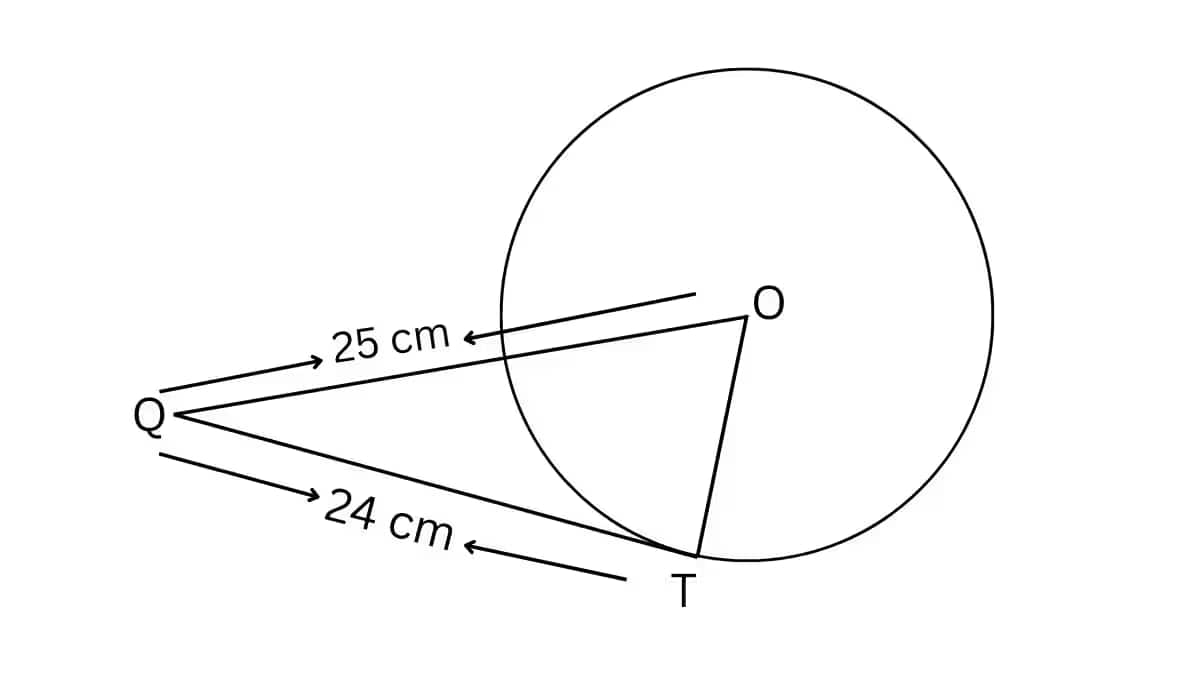
Given that,
The length of the tangent (QT) is 24 cm and the length of OQ is 25 cm.
Suppose the length of the radius OT be
We know that
OT = 7 cm
(A)
(B)
(C)
(D)
Answer:
The correct option is (b)
In figure,
Since POQT is quadrilateral. Therefore, the sum of the opposite angles is
(A) 50°
(B) 60°
(C) 70°
(D) 80°
Answer:
The correct option is (A)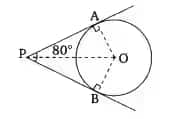
![]()
It is given that, tangents PA and PB from point P are inclined at
In triangle
OA =OB (radii of the circle)
PA = PB (tangents of the circle)
Therefore, by SAS congruence
By CPCT,
Now,
In
=
Q4 Prove that the tangents drawn at the ends of a diameter of a circle are parallel.
Answer: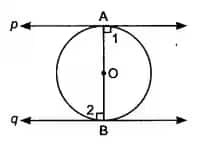
Let line
OA and OB are perpendicular to the tangents
Therefore,
Answer:
In the above figure, the line AXB is the tangent to a circle with centre O. Here, OX is the perpendicular to the tangent AXB (
Therefore, we have,
Answer:
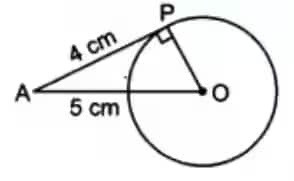
Given that,
The length of the tangent from the point A (AP) is 4 cm, and the length of OA is 5 cm.
Since
Therefore,
Answer:
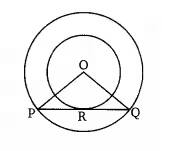
In the above figure, PQ is the chord to the larger circle, which is also tangent to a smaller circle at the point of contact R.
We have,
Radius of the larger circle OP = OQ = 5 cm
Radius of the small circle (OR) = 3 cm
OR
According to the question,
In
OR = OR {common}
OP = OQ {both radii}
By RHS congruence
So, by CPCT
PR = RQ
Now, In
By using Pythagoras' theorem,
PR = 4 cm
Hence, PQ = 2.PR = 8 cm
.jpg)
Answer:
To prove- AB + CD = AD + BC
Proof-
We have,
Since the lengths of the tangents drawn from an external point to a circle are equal
AP =AS .......(I)
BP = BQ.........(ii)
AS = AP...........(iii)
CR = CQ ...........(iv)
By adding all the equations, we get;
Hence proved.
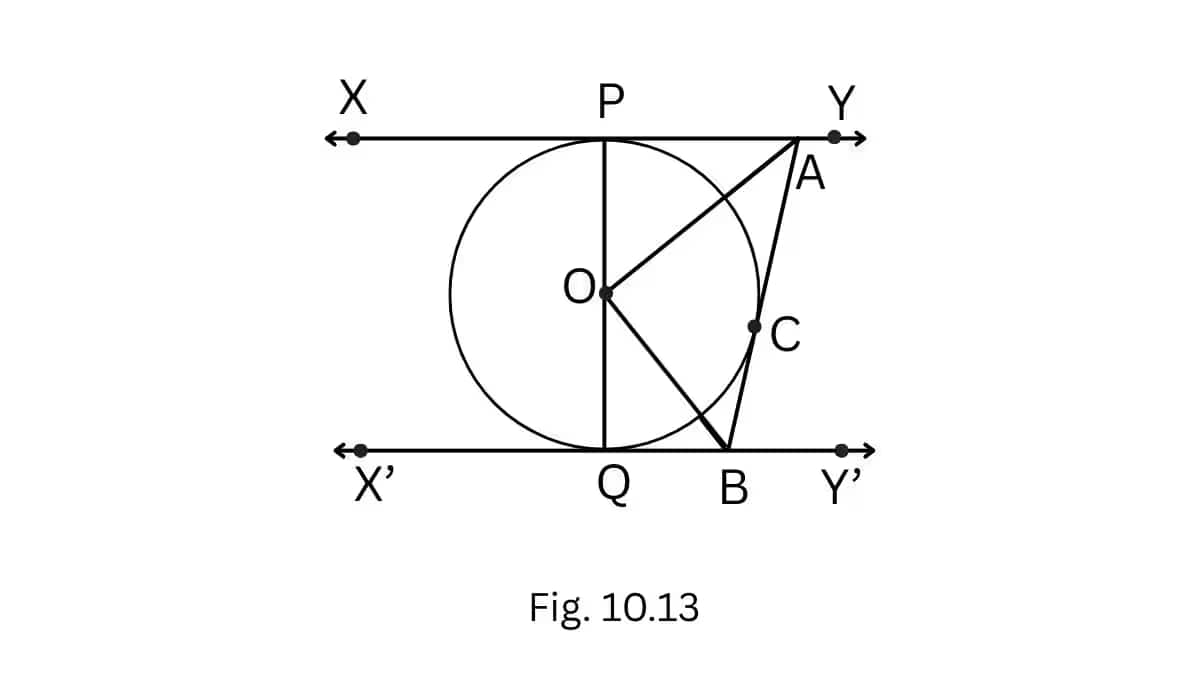
Answer:
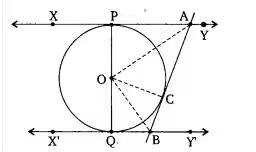
To prove-
Proof-
In
OA =OA [Common]
OP = OC [Both radii]
AP =AC [tangents from external point A]
Therefore by SSS congruence,
And by CPCT,
Similarly, from
Adding equations (1) and (2)
2(
(
Now, in
The sum of the interior angles is 1800.
So,
Hence proved.
Answer:
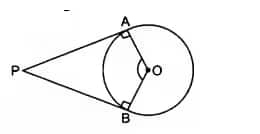
To prove -
Proof-
We have PA and PB are two tangents, and B and A are the points of contact of the tangents to a circle. And
According to the question,
In quadrilateral PAOB,
Hence proved.
Q11 Prove that the parallelogram circumscribing a circle is a rhombus.
Answer: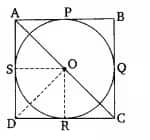
To prove - the parallelogram circumscribing a circle is a rhombus
Proof-
ABCD is a parallelogram that circumscribes a circle with centre O.
P, Q, R, and S are the points of contact on sides AB, BC, CD, and DA, respectively
AB = CD .and AD = BC...........(i)
It is known that tangents drawn from an external point are equal in length.
RD = DS ...........(ii)
RC = QC...........(iii)
BP = BQ...........(iv)
AP = AS .............(v)
By adding eq (ii) to eq (v) we get;
(RD + RC) + (BP + AP) = (DS + AS) + (BQ + QC)
CD + AB = AD + BC
Now, AB = AD and AB = CD
Hence, ABCD is a rhombus.
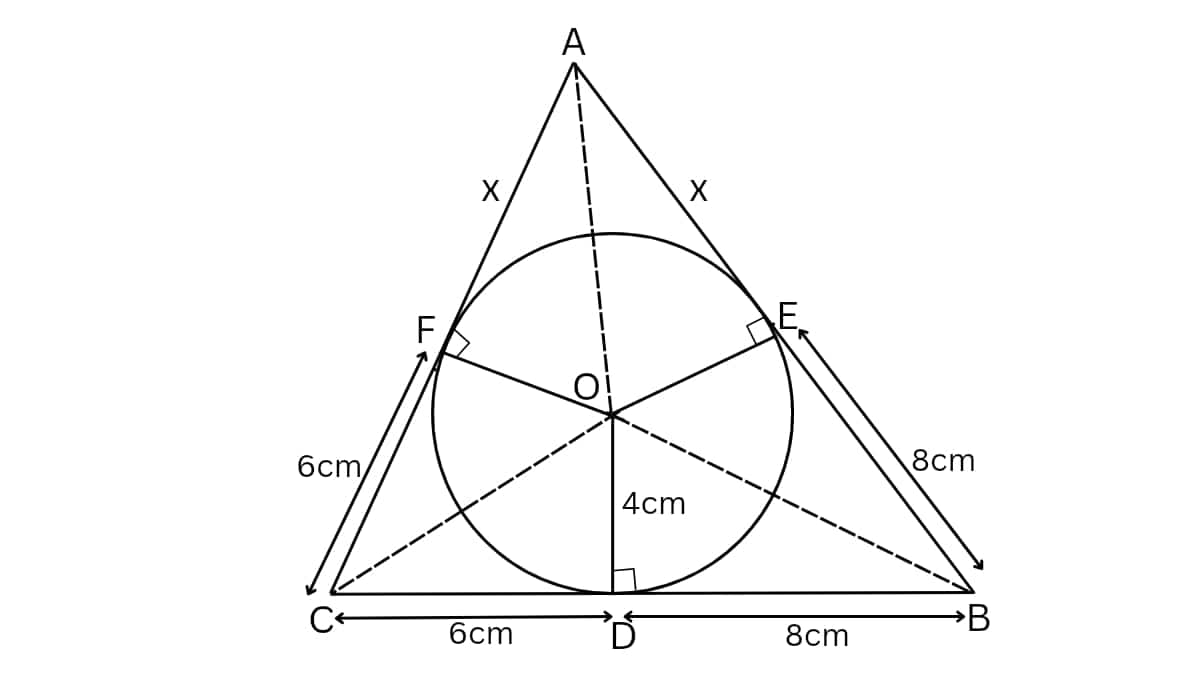
Consider the above figure. Assume centre O touches the sides AB and AC of the triangle at points E and F, respectively.
Let the length of AE is x.
Now in
Now, AB = AE + EB
Now,
Area of triangle
Now the area of
Area of
Area of
Now, Area of the
On squaring both sides, we get
Therefore,
Answer- AB = 15 and AC = 13
Answer: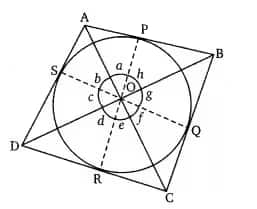
Given- ABCD is a quadrilateral circumscribing a circle. P, Q, R, and S are the points of contact on sides AB, BC, CD, and DA,
respectively.
To prove-
Proof -
Join OP, OQ, OR and OS
In triangle
OD =OD [common]
OS = OR [radii of same circle]
DR = DS [length of tangents drawn from an external point is equal ]
By SSS congruency,
and by CPCT,
Similarily,
SImilarily,
Hence proved.
Also Read
Topics covered in Chapter 10.2 Circles: Exercise 10.2
This exercise contains basic questions to represent the problems of finding radii using the distance formula and Pythagoras' Theorem. End Questions of Class 10 Maths chapter 10 exercise 10.2 belongs to finding the distance between two tangents and the relation of line and circle. In the NCERT syllabus, Class 10 Maths chapter 10 exercise 10.2 also covers problems of co-centric circles and numerical problems related to chords and centres, and circumscribing a circle.
- Tangent to a Circle: Tangent is a line segment that touches or intersects the circle at only one point.
- Secant of a Circle: A secant is a line that intersects a circle at two distinct points.
- Chord of a Circle: A chord is a line segment whose endpoints are on the circumference of the circle.
- Point of Contact: A point where a tangent touches a circle is called the point of contact.
- Theorem: The length of the line segments of tangents drawn from an external point to a circle is equal.
- Number of Tangents: Some facts about the number of tangents are as follows -
- From a point inside the circle, no tangent can be drawn.
- From a point on the circle, one tangent can be drawn.
- From a point outside the circle, two tangents can be drawn.
Also see-
NCERT Solutions Subject Wise
Students must check the NCERT solutions for Class 10 Maths and Science given below:
Subject-Wise NCERT Exemplar Solutions
Students must check the NCERT exemplar solutions for Class 10 Maths and Science given below:
Frequently Asked Questions (FAQs)
A curved line whose ends meet and all points on the line are at the same distance from the centre or a path that revolves around a central point or a group of items arranged is called a circle.
The shortest distance between two parallel tangents of the circle is Diameter i.e. twice the radius of given circle
a circle can be formed by three points but the condition is the points must be non-collinear non-parallel.
The sum of interior angles of a quadrilateral is 360 degrees.
The degree 3 polynomial is referred to as Cubic polynomials is a type of polynomial in which there are
If in a circle if two tangents are parallel and another tangent from parallel tangent one cuts parallel tangent 2 forming two triangles. If these triangles have three sides in common then these triangles are equal by sss congruence.
The line intersecting circle at two points is called a Secant
Questions related to CBSE Class 10th
On Question asked by student community
The CBSE Sahodaya Question Papers for Class 10 (2025-26) are not released centrally by the board as a single PDF.
Here is the essential information you need:
-
Local Release: The papers are designed and released by the individual Sahodaya School Clusters (groups of CBSE schools) just before or during the pre-board exam dates (typically held in December and January). Therefore, you must check your local cluster's portal or directly with your school administration.
-
Best Practice: The official model papers, based on the full 2026 syllabus, are the most reliable tool for practice. These accurately reflect the structure, format, and competency-based questions used in the Sahodaya exams.
You can download the latest CBSE Class 10 Model Papers to simulate the Sahodaya tests here: https://school.careers360.com/articles/sahodaya-question-paper-2025 . Focus on that pattern
Hi! If you’re looking for the Class 11 English half yearly question paper for 2025-26 (CBSE board), you’ll find the right resource once you check the link provided from Careers360. Solving previous or sample papers is a smart way to prepare, as it helps you understand the question types, marking scheme, and important topics. This practice will boost your confidence and help you manage your time well in the actual exam.
https://school.careers360.com/boards/cbse/cbse-class-11-half-yearly-sample-papers-2025-26
Hi dear candidate,
Could you please specify us the board of education for which you need the half yearly question papers of class X so that we can help you further.
Below are few links which may help you and it has all the subjects with English as well:
CBSE Class 10 Half Yearly Exam Question Paper 2025-26 with Answer Key & Analysis
ICSE Class 10 Half Yearly Sample Papers 2025-26 PDF (All Subjects)
BEST REGARDS
Hi dear candidate,
Can you please specify the board of education or state for which you need to know the exam pattern and syllabus so that we can guide you accordingly.
Since, most of the boards uses NCERT as base syllabus, you can refer to the link below:
NCERT Syllabus for Class 10 – All Subjects PDF Download 2025-26
Exam pattern:
CBSE 10th New Exam Pattern 2026- Marking Scheme, Subject-Wise Exam Pattern
BEST REGARDS
The CBSE Class 10th Board Exams for the 2026 session will follow the revised curriculum, emphasizing competency-based questions.
-
Conducting Body: Central Board of Secondary Education (CBSE).
-
Exam Period: The main theory exams are typically held between February and April 2026.
-
Grading: Based on marks in five main subjects plus internal assessment marks (often 20 marks per subject) provided by the school.
-
Passing Criteria: You must achieve at least 33% overall in each subject (theory + practical/internal assessment combined) to be declared pass.
Key Preparation Strategy
The most crucial element of your preparation is understanding the exam structure:
-
Syllabus: Strictly adhere to the rationalized syllabus released by CBSE for the 2025-26 academic year.
-
Practice: Your primary resource should be the latest sample papers and previous year question papers. These accurately reflect the format and types of competency questions being asked.
For the most comprehensive and official announcements, including the detailed time table and access to crucial practice materials, always check the official board updates, as tracked by Careers360: https://school.careers360.com/exams/cbse-class-10th .
Applications for Admissions are open.
As per latest syllabus. Physics formulas, equations, & laws of class 11 & 12th chapters
JEE Main Important Chemistry formulas
Get nowAs per latest syllabus. Chemistry formulas, equations, & laws of class 11 & 12th chapters
JEE Main high scoring chapters and topics
Get nowAs per latest 2024 syllabus. Study 40% syllabus and score upto 100% marks in JEE
JEE Main Important Mathematics Formulas
Get nowAs per latest syllabus. Maths formulas, equations, & theorems of class 11 & 12th chapters
